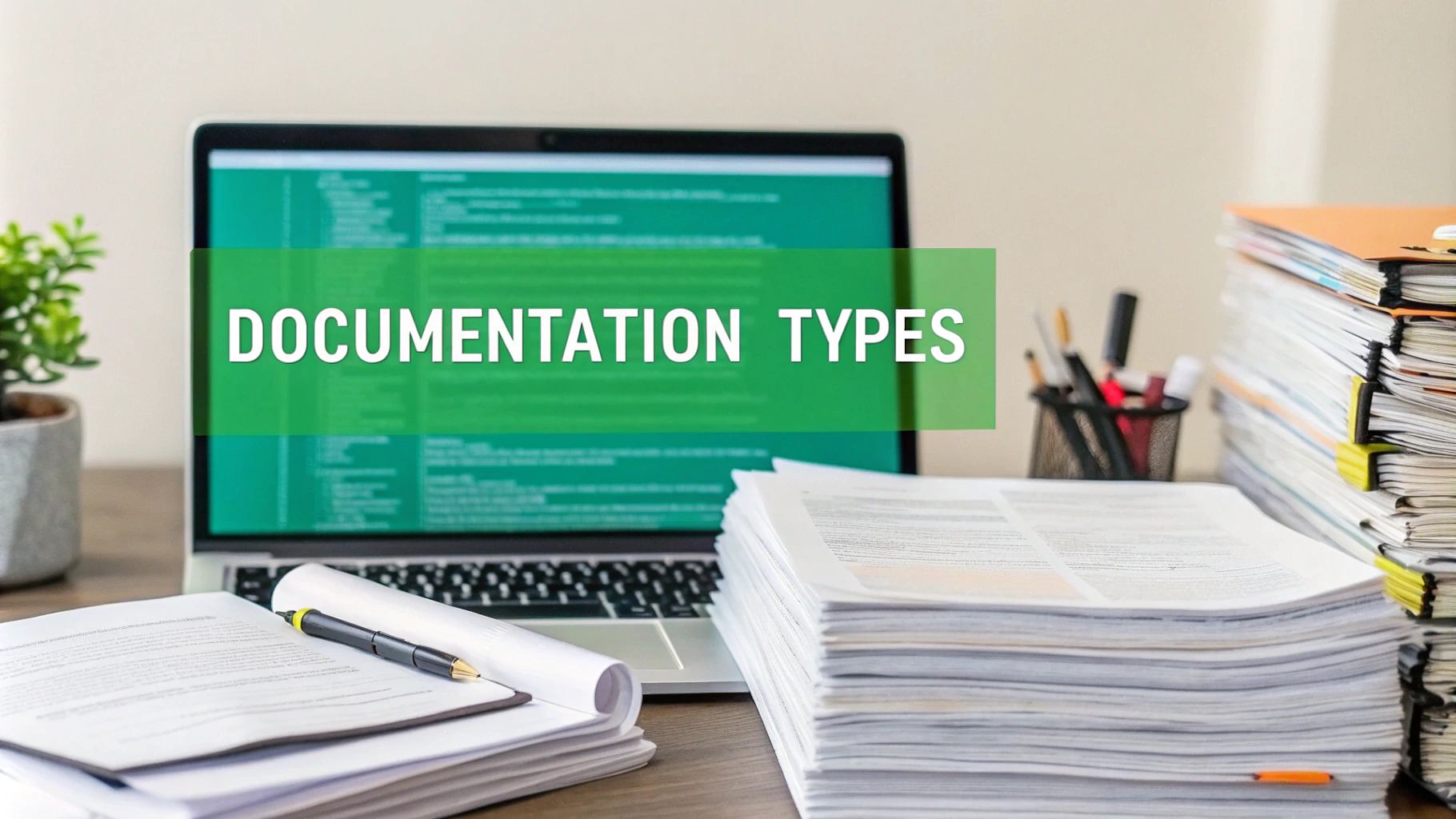Learn best practices for documenting code effectively. Explore various documentation styles, tools, and strategies to improve code maintainability, collaboration, and onboarding.

Clear, concise, and comprehensive code documentation is essential for any successful software project. Just as a complex machine requires a detailed manual for operation and maintenance, code documentation acts as the instruction manual for software, guiding developers through its intricacies. This guidance ensures long-term maintainability and makes understanding the codebase significantly easier. Therefore, learning how to document code effectively is a crucial skill for every developer.
Thorough code documentation offers numerous benefits, both for individual developers and entire teams. For instance, well-documented code dramatically improves readability, making it simpler for others (and your future self) to navigate and modify the codebase. Robust documentation also minimizes errors by clarifying the intended function of each code section. This clarity speeds up debugging and maintenance, saving valuable time and resources.
Beyond bug fixing, proper code documentation facilitates team collaboration. When multiple developers work on the same project, consistent and clear documentation keeps everyone aligned, reducing misunderstandings and boosting efficiency. Moreover, effective documentation streamlines onboarding new team members. New developers can quickly grasp a well-documented project, becoming productive contributors much faster. These factors contribute to a smoother development process and a higher-quality final product, making clear documentation an investment in project success.

Effective code documentation involves understanding the various types that contribute to a well-rounded project. These different forms serve distinct purposes, addressing different audiences and providing varying levels of detail. Much like a building requires blueprints, electrical diagrams, and user manuals, software projects benefit from a multi-layered documentation approach. This ensures clarity and accessibility for everyone involved, from developers to end-users. Let’s delve into these types.
Inline comments, placed directly within the code, provide context and explanations for specific lines or blocks. They explain the reasoning behind the code, such as the purpose of a complex algorithm or the choice of a particular data structure. This is incredibly helpful during debugging or later modifications. However, it’s important to use inline comments judiciously, focusing on clarifying complex logic rather than stating the obvious. Over-commenting can hinder readability, making the code cluttered and difficult to follow. This leads us to other forms of documentation better suited for broader explanations.
README files, located at the project’s root, serve as the introductory guide. Think of it as the project’s preface, providing an overview of its purpose, functionality, and how to get started. A good README includes information on installation, dependencies, and contribution guidelines. It can also act as a central hub linking to other documentation resources. This comprehensive approach helps anyone, from experienced developers to first-time users, quickly understand the project’s basics.
API documentation focuses on explaining how to interact with a software library or API. It’s the essential guide for developers integrating the API into their projects. API documentation clearly defines available functions, classes, methods, parameters, return values, and potential exceptions. For example, it might explain authentication, data retrieval, or how to perform specific actions. Good API documentation often includes examples and tutorials, simplifying integration for developers. This detailed information is critical for smooth integration and minimizing potential problems. Effective API documentation empowers developers to use the API successfully, fostering collaboration and expanding the software’s reach.
Effective code documentation goes beyond simply adding comments; it requires a strategic approach based on best practices. These practices are like building codes for software, providing a framework for robust and understandable documentation. By following these guidelines, documentation becomes a valuable asset rather than a burden.
Documentation should be easily understandable. Use clear and concise language, avoiding jargon unless necessary. Consider the target audience and tailor explanations accordingly. For instance, API documentation for external developers needs more detail than internal documentation for a small, familiar team. Avoid ambiguity and strive for precision. Vague or inaccurate documentation can lead to errors and delays, much like a poorly written instruction manual.
Consistency in documentation is crucial for readability and maintainability. This means using a consistent style for comments, formatting, and terminology. For example, establish a standard format for documenting function parameters and stick to it. This consistency simplifies navigation and understanding of the codebase. Inconsistent documentation makes it difficult to understand and use the code effectively, highlighting the importance of consistency for usability and long-term value.
Code documentation, like the code itself, needs regular updates. Reflect any code changes in the documentation to prevent it from becoming outdated and misleading. This applies to README files and API documentation as well. For instance, update API documentation immediately after adding a new feature. This diligent approach ensures the documentation remains a reliable resource. Integrate documentation into the development workflow, treating it as an ongoing process. This promotes accuracy and minimizes the risk of outdated documentation. Learn more in our article about how to master best practices for code documentation. You might be interested in: How to master best practices for documentation with AI assistance. This can automate the process, ensuring documentation mirrors the code’s current state.
While following best practices is essential, the right tools can significantly improve code documentation. Developers benefit from various tools designed to streamline the process and enhance the final product. These tools range from simple text editors to advanced documentation generators, each with unique advantages. Choosing the right tool is crucial for efficient and effective documentation.

Documentation generators automate documentation creation, saving time and ensuring consistency. They analyze the codebase, extracting information from comments and function signatures to generate formatted documentation in various formats like HTML, PDF, or Markdown. Tools like Doxygen, Javadoc, and Sphinx are popular for generating API documentation directly from source code. This allows developers to focus on writing clear comments while the generator handles assembling them into a well-structured document, ensuring the documentation always reflects the code’s current state.
Specialized tools are indispensable for documenting APIs. These tools go beyond basic generators, offering features like interactive explorers and code examples. Swagger, Postman, and Slate are excellent examples, streamlining API documentation creation and sharing. Swagger lets developers define API endpoints, parameters, and responses in a standardized format, generating interactive documentation for testing API calls directly from a browser. Tools like Postman offer API testing and debugging features, enhancing the developer experience and making API documentation more accessible and valuable.
Static site generators offer a flexible and powerful way to create and manage documentation websites. They convert source files written in Markdown or other formats into a complete website. Jekyll, Hugo, and Gatsby are popular choices, offering version control, easy customization, and fast loading times, resulting in a user-friendly experience. They allow for dedicated documentation websites with search functionality and visually appealing designs, presenting documentation professionally and improving accessibility, which is particularly beneficial for open-source projects and APIs aiming for a broad audience. These tools are increasingly popular due to their simplicity and versatility. This enhances presentation and accessibility, improving user experience and fostering wider project engagement.
Understanding code documentation involves seeing how principles apply in practical scenarios. This section provides concrete examples across different documentation types, illustrating how clear and concise documentation improves code understanding and maintainability.

Consider a function calculating a factorial:
The docstring clearly explains the function’s purpose, inputs, outputs, and potential exceptions. The comments explaining why the function returns 1 for n=0 add valuable context, making the code easier to understand and maintain.
A README provides a project overview:
This README provides essential information: installation, usage, contribution guidelines, and licensing. It gives anyone interacting with the project a clear starting point.
API documentation is crucial for explaining interaction with specific functions:
This example defines the parameter and return types and includes an example, demonstrating the function’s usage and enhancing understanding, which is essential for easy integration and use by other developers.
These examples show how different documentation types provide a complete picture of effective code documentation. By following these examples and incorporating best practices, you can create documentation that enhances readability, maintainability, and overall code quality, improving collaboration, onboarding, and contributing to long-term project success. Remember that learning how to document code is an ongoing process, and continually refining your skills will undoubtedly improve your code and make you a more effective developer.
Effective code documentation is an investment in any software project’s future. We’ve explored various aspects, from understanding documentation types to implementing best practices like clarity, consistency, and keeping documentation updated. Simply scattering comments is insufficient; strategic documentation considers the purpose and audience, tailoring the detail level for clarity and accessibility. API documentation requires clear explanations of functions and parameters, while a README provides a project overview.
Leveraging the right tools enhances the documentation process. Documentation generators automate creation, ensuring consistency and saving time. API documentation tools offer specialized features like interactive explorers. Static site generators enable professional documentation websites, improving accessibility. Choosing the right tool depends on project needs and the type of documentation being created. Efficient code documentation involves selecting tools that streamline workflow and improve quality.
We examined real-world examples, demonstrating how these principles apply practically. From Python functions with clear docstrings to comprehensive READMEs and well-structured API documentation, these examples showcased the power of effective documentation in enhancing code understanding and maintainability. By studying these examples and incorporating best practices and tools, developers can improve their documentation skills and contribute to project success. Effective code documentation is not merely a technical skill but a vital practice contributing to any software project’s overall quality and maintainability.
Tired of struggling with tedious documentation? DocuWriter.ai offers AI-powered solutions to automate generating clear, concise, and consistent code documentation. From API documentation to UML diagrams and code refactoring, DocuWriter.ai streamlines the entire process. Visit DocuWriter.ai today and experience the future of code documentation.